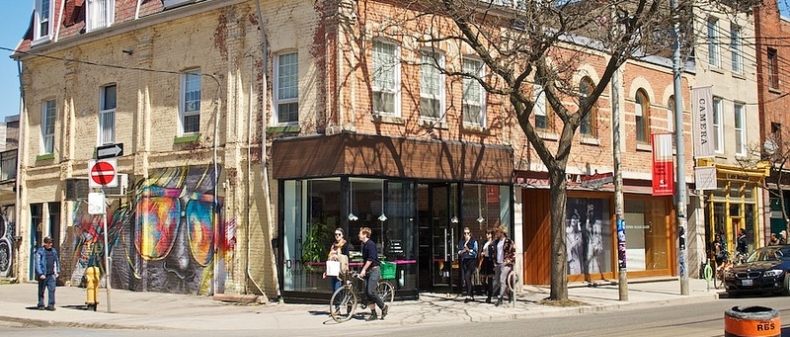
Image via flickr user Uncle Lynx
It is a truth universally acknowledged that sun-starved Torontonians on a warm weekend must be in want of a park. And if you live anywhere near Queen Street, Trinity Bellwoods is probably where you’ll go. These days it’s tough to find a stretch of grass that’s not covered in somebody else’s bike or beach towel.
Beyond Bellwoods lies West Queen West – technically Toronto’s Art and Design District. And you can tell it’s an arty crowd. In Bellwoods it’s rompers, cut-off shorts and haircuts you were too scared to try (I’ve been thinking of getting a side shave, thoughts?). Indeed, that one-kilometer strip between Bellwoods and Dufferin has one of the densest concentrations of galleries in the city.
The thing about art and design is that it’s often so difficult to describe why we like certain pieces. Why am I really into the print on that girl’s maxi dress? Why am I really not into the squiggly lines in that painting in the gallery across the street? Of course, leave it to the neuroscientists to try to figure it out.
The science of neuroaesthetics studies how and why we respond to art. It looks at what’s going on in our brains when we take in a painting or drawing or sculpture. It’s also a relatively young field – it was only in 2002 that Semir Zeki from University College London got the idea to put people in a brain scanner as they looked at art.
There’s an evolutionary edge to neuroaesthetics research. Scientists say that humans are the only organisms able to appreciate and evaluate beauty in what they see. They’ve even suggested that seeing beauty was an evolutionary advantage in humans. In other words, “ugly” traits like asymmetry are biologically associated with infection and disease, and could lead you to select a bad mate. But as far as evolutionary psychology goes, we can’t actually go back in time to look at survival rates in early humans who did or didn’t have an aesthetic side – we can only speculate about the origins of our ability to discern beauty.
When it comes to studying modern-day humans, research generally looks at how our reactions to art are mapped out in the brain. In one experiment, scientists asked participants to judge artworks as beautiful, ugly, or neutral. They were then asked to observe these paintings while researchers used an fMRI scanner (basically a big magnet that can visualize your brain activity over time) to study the parts of the brain activated during the task. One study showed that the orbitofrontal cortex (OFC) – an area involved in emotion and feelings of reward – activated less in response to ugly stimuli, while beautiful stimuli resulted in increased OFC activity. And it makes sense: if you like a piece of art, it’s more likely to trigger an emotional response, as well as a sense of pleasure.
But the aesthetic experience isn’t just about perception of visual objects. Observing art also triggers parts of the brain responsible for movement and physical sensation. That is, when you look at art, your brain is reenacting a whole set of actions and emotions, creating that visceral or embodied feeling you get when you experience a piece of art.
Another area of neuroaesthetics research is interested in the question of what makes art good. What’s so different about Cy Twombly that means a third grader couldn’t do it? One theory explains that there are certain laws of artistic experience (usually pegged at eight), which correspond both to artistic principles and specific visual parts of the brain.
One of these laws, called the peak shift principle, suggests that in the attempt to capture the “essence” of an object, artists will often exaggerate the related forms or lighting of the object in ways that would otherwise look unrealistic. Basically, artists highlight the features of objects that make them unique. According to researchers, the process of amplifying unique features actually mimics the way the visual areas of the brain treat information. Observing a painting that uses this technique should therefore amplify the neural effect, and could explain why you like it.
Research along those lines makes it sound like art is really just a matter of using the right visual cues to trigger a specific brain response. And on some level, that seems intuitive. But the research also runs the risk of missing the complexity of how experience beauty. Just because you can point to a smudge of colour on a brain scan when you happened to be looking at the Mona Lisa, it doesn’t mean you can tell what you liked about it, or even why.
So when I’m in Bellwoods, secretly checking out people’s outfits I like, I don’t think of my orbitofrontal cortex lighting up. Sure, that may very well be happening, but it doesn’t explain why I like their style. Neuroaesthetics probably has a long way to go before it can get a better picture of our brains on art. Until then, we can take in the art along West Queen West, blissfully unaware of our neurons.
____
Erene Stergiopoulos writes about brains and neighbourhoods for Toronto Standard. Follow her on Twitter @fullerenes.
For more, follow us on Twitter @TorontoStandard and subscribe to our newsletter.














